You’ve likely spotted it in the mall ever since you were a teenager: the Bath & Body Works store, in all its scented, vibrantly-hued glory. With all those helpful employees standing at the ready in their checkered aprons and with cleverly named scents like “Sunkissed” and “Endless Weekend,” it can certainly be tough to resist all that beautifully packaged goodness and delicious-smelling aromas.
Although we can all agree that nearly everything in a Bath & Body Works store smells great, there are some things to keep in mind when shopping their products—specifically, if you’re interested in purchasing anything from their Wallflower line. Are Bath and Body Works Wallflowers toxic? Let’s break down the potential risks to you and your family, and what to use instead.
Table of Contents
- What Is A Bath & Body Works Wallflower?
- How Do You Use A Bath & Body Works Wallflower?
- Is It Safe to Leave A Wallflower Plugged in All The Time?
- What Is An “Air Freshener?”
- Are Bath and Body Works Wallflowers Toxic? What Makes Them Unsafe?
- Are Bath & Body Works Wallflowers Safe Humans and For Pets?
- Are Wallflower Air Fresheners Toxic to Me and My Family?
- How Do Wallflowers Air Fresheners Affect Cats?
- Will Bath & Body Works Wallflowers Hurt My Dog?
- Are There Safer Options to Bath & Body Works Wallflowers?
- Use Non-Toxic Products to Clean and Deodorize Your Home
- Aera
- Grow
- Moso Natural
- All-Purpose Cleaning Products
- Other Ways to Scent Your Home
- What about Bath and Body Works’ Other Products?
This post contains affiliate links, which means we may earn a small commission if you choose to make a purchase. We only make recommendations that are genuine and meet our ingredient/material safety standards.
What Is A Bath & Body Works Wallflower?
Much like the plug-in air fresheners you see lining the shelves at grocery stores and big-box retailers, Bath & Body Works Wallflowers are plug-in air fresheners that are an offshoot of their other scented products, which include lotions, body washes, and candles. They’re marketed as “always-on” fragrances, which are plugged in and feature white plastic flowers that distribute aromas into the air. They feature scents that include “Crisp Morning Air,” “Berry Waffle Cone,” “Lavender Vanilla,” and more.
How Do You Use A Bath & Body Works Wallflower?
You simply plug a Wallflower right into a wall outlet, just like the plug-in air fresheners you see at mainstream stores. You can replace the scents with refills. The plugs themselves last around two years, while the refills each last about 30 days.
Is It Safe to Leave A Wallflower Plugged in All The Time?
Generally, it’s safe to leave a Wallflower, or any plug-in air freshener, plugged in for long periods of time since they use very little electricity. The only instance in which plug-in air fresheners can become fire hazards is if there is faulty wiring (which has nothing to do with the freshener itself).

What Is An “Air Freshener?”
Whether it’s plugged in, sprayed, or presented as gel in a plastic container, an air freshener is a product that releases fragrances into the air. It doesn’t actually clean the air or decrease indoor air pollution in any way, but rather just masks odors with another, more pleasant scent.
Can Air Fresheners Hurt You?
Experts generally agree that over time, the chemicals in traditional air fresheners, plug-in or otherwise, can impact health and overall wellbeing. Although these chemicals make things easier for the companies that create the air fresheners (in the interest of saving money or being efficient during the manufacturing process), they aren’t ideal to breathe in and out all day long in your home.
Air fresheners contribute to indoor air pollution (which can actually be worse than outdoor pollution) and release toxins into the air that can bring about a host of health woes, from respiratory difficulties to even cancer.
How Does A Bath & Body Works Wallflower Freshen the Air?
Since Wallflower refills are made up of fragrance oils, when you plug one in, the electricity heats up the oil and releases the aroma into the air. Again, Wallflowers don’t technically freshen the air, but rather adds synthetic fragrance into the air to mask other smells.
Home
Are Bath And Body Works (& White Barn) Candles Toxic Or Bad For You?
Let’s discuss why Bath & Body Works/White Barn candles are toxic, what’s inside them, how they affect people and pets, and a few healthier candle alternatives.
Are Bath and Body Works Wallflowers Toxic? What Makes Them Unsafe?
Even though Bath & Body Works shares that Wallflowers are crafted using essential oils (which sound totally natural, right?), unfortunately, those oils are mixed with not-so-great-for-you chemicals as well. These chemicals include:
Formaldehyde
While it is something frequently used in scientific labs, formaldehyde isn’t the best thing to be releasing into your home. It is a frequently-used chemical in a wide variety of products, from glues to cosmetics to dishwashing liquids to paint, but it’s still not something you’ll want to inhale on a regular basis. In fact, in Europe, it’s a chemical that’s very strictly regulated due to its carcinogenic properties, something that the National Cancer Institute has confirmed.
Phthalates
Phthalates are chemicals that are often found in personal care products: think anything fragranced like soap, shampoo, and air fresheners. It’s used to make fragrances last longer, which is why that Wallflowers scent continues smelling fresh and aromatic long after you first plug it in.
Fragrance
Unfortunately, the U.S. laws and regulations around ‘fragrance’ and/or ‘parfum’ allow companies to include various toxic chemicals in their products without listing them on the ingredients label. You can read more about that right here.
VOCs
“VOC” stands for “volatile organic compound,” a term that generally applies to various chemicals that can easily turn into gas, which then turns into vapor in the air. VOCs greatly contribute to indoor air pollution, something that doesn’t bode well for the lungs and heart. You can read more about VOCs here.
Other Additives
It doesn’t stop there. Bath & Body Works’ Wallflower formulations also include other potentially problematic ingredients, such as colorants (some of which are safer than others), propylene glycol (which can cause various negative effects at higher/prolonged doses and is banned in Europe), and various other petroleum-based synthetics.
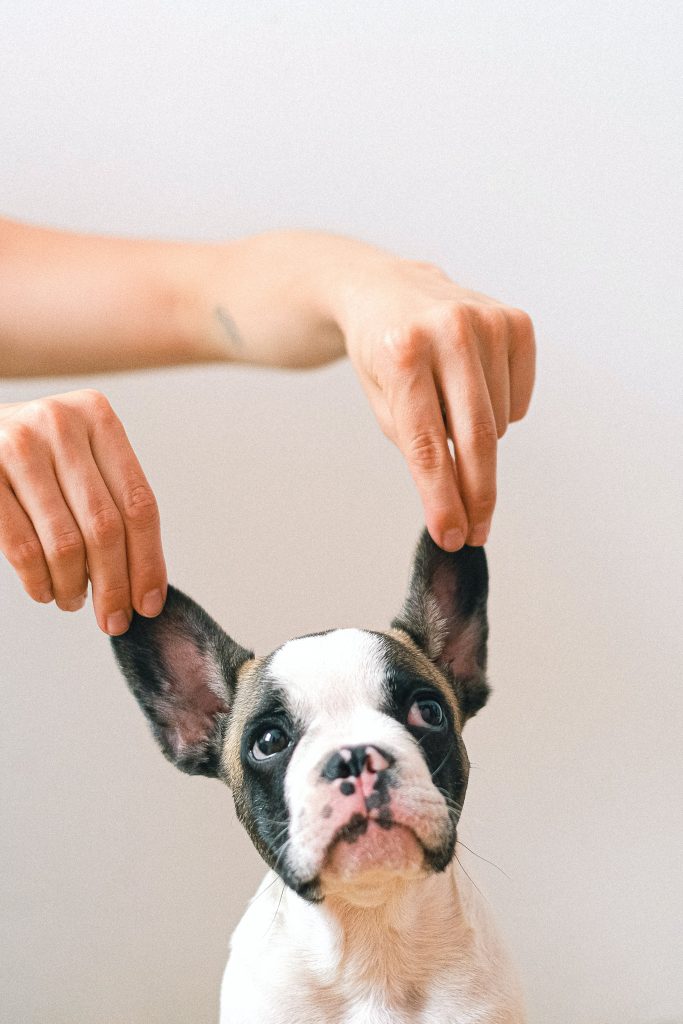
Are Bath & Body Works Wallflowers Safe Humans and For Pets?
Because Wallflowers have chemicals that aren’t the best to be inhaling within your home, the same thing goes for your furry friends as well.
Are Wallflower Air Fresheners Toxic to Me and My Family?
Since Wallflowers contain ingredients like formaldehyde, phthalates, and VOCs, this can make them potentially toxic to you and your family when inhaled. Short-term air freshener poisoning symptoms can include allergy symptoms, hormone disruption, coughing, stomach upset, and more. When encountered on the skin, air freshener fragrances can bring on rashes and skin irritation. And if you have small children, be forewarned that plug-in air fresheners are their deadliest when ingested.
How Do Wallflowers Air Fresheners Affect Cats?
According to PetMD, the essential oils contained in air fresheners like Bath & Body Works Wallflowers can be very toxic to cats. It’s imperative that your cat, or any of your pets, do not ingest the air freshener. When inhaled, a Wallflower or any other air freshener can cause cats to develop feline asthma or neurological problems.
Will Bath & Body Works Wallflowers Hurt My Dog?
The same goes for dogs. Canines can develop neurological problems just like cats as a result of inhaling air fresheners. These symptoms can include unsteadiness, weakness, and tremors, as PetMD shares. Dogs can also experience asthma and allergies from breathing in air fresheners.
Are There Safer Options to Bath & Body Works Wallflowers?
While it’s certainly better to use air fresheners in your home that contain more natural ingredients that haven’t been mixed with worrisome chemicals, you should know that not all essential oils are ideal for your pets to be around.
For humans, however, most essential oils are completely safe when emitted into the air. (Unless, of course, you’re allergic to them.) For this reason, you may want to consider purchasing one of these non-toxic air freshener plug-ins instead of Bath & Body Works Wallflowers.
Home
5 Safest Non-Toxic Plug-In Air Fresheners in 2024
If you’re doing an overhaul on your household products, a good place to start is with non-toxic plug-in air fresheners. Making the switch is pretty darn easy in 2024!
Here are some other ways to make your home smell good so you can ditch the Bath & Body Works Wallflowers:
Use Non-Toxic Products to Clean and Deodorize Your Home
Aera
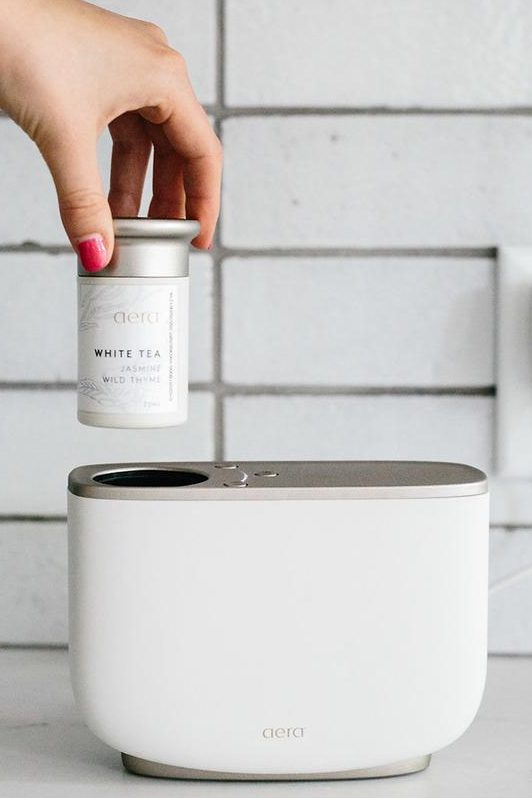
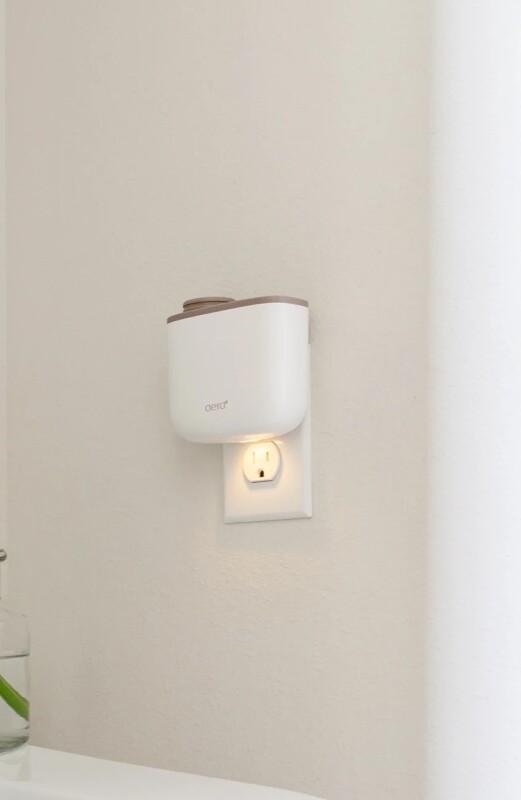
This company purveys diffusers that hold canisters of natural scents. Lasting a whopping 800 hours with a scent that doesn’t change over time, you can choose from scents like “Linen,” “Citrus,” and “Mint and Eucalyptus.”
The Aera Mini is a plug-in that can easily replace your BBW Wallflower. It even comes with an app so that you can control it from your phone, edit the strength of the scent, put it on a schedule, and more.
Scent Fill is another great non-toxic option that offers plug-in air fresheners!
Grow

These plant-based air fresheners can be spritzed around your home or in your car and don’t carry those chemicals derived from petroleum. Freshen up the air and your home and feel better knowing that this company provides ingredient transparency, ranging from essential oils to hexenyl acetate, found in green tea, to alcohol that’s been naturally fermented from grains.
Choose from scents like Lavender Blossom, Citrus Cedar, Bamboo, and more.
Moso Natural
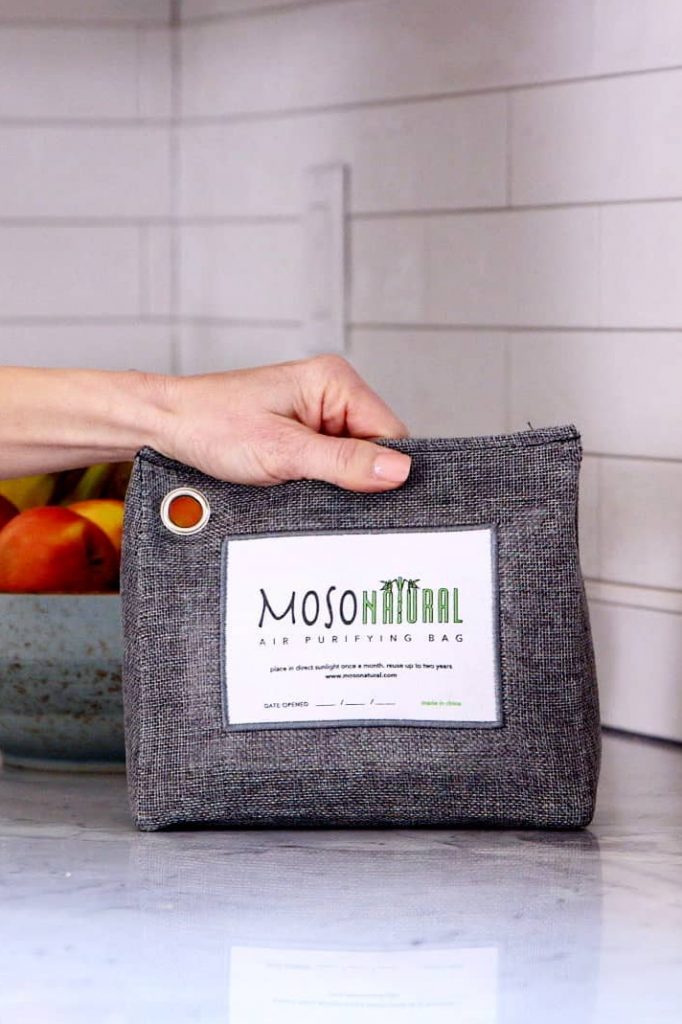
Moso’s completely non-toxic odor-absorbing bags come in various shapes and sizes, which you can place all throughout your house. By setting a bag in the kitchen, bathroom, closet, or laundry room, this is a great way to actually get rid of odors (instead of just masking them).
These bags last a really long time, too. Simply let the bag soak in the sun every once in a while to refresh it and then reuse them for up to two years.
All-Purpose Cleaning Products


Of course, one of the best ways to keep odors at bay and your home smelling fresh is to keep it clean. There are a number of all-purpose cleaners we recommend, including Branch Basics and Force of Nature. These non-toxic and refillable household cleaners can be used to keep bathroom and living spaces fresh!
Other Ways to Scent Your Home
You can always choose to purchase an air-freshening product with a pre-made scent, or you can customize the scent by turning to other products and hacks. For example, an essential oil diffuser is a great way to create your own blends by using the organic essential oils of your choice. Boiling citrus peels in a stockpot can immediately release an orange-filled scent into your space. Ionic air sanitizers, which circulate negatively charged ions into the air, can also make your home feel a lot fresher.
What Are Pet-Safe Essential Oils?
While it’s best to confirm with your vet, it’s generally believed that some essential oils are safe for pets and others are not. According to Rover.com, the essential oils that have been deemed safe for dogs include lavender, copaiba, frankincense, peppermint, and petitgrain. The American Kennel Club (AKC) shares that cinnamon, citrus, pine, tea tree, ylang ylang, and other essential oils can be poisonous to dogs. Experts can disagree on the toxicity of some essential oils (i.e. some say that peppermint is safe while others believe that it’s not). This is why it’s imperative to check with your vet before using essential oils in your home, whether they’re diffused or applied.
Essential Oils That Aren’t Good for Your Cat
Just like dogs, some essential oils can be quite irritating for your feline friend. These include the same essential oils that are troublesome for dogs, like cinnamon, citrus, and tea tree. Again, check with your vet before using essential oils in any way.
What about Bath and Body Works’ Other Products?
Bath and Body Works sells other products like candles, body sprays, shampoos, soaps, and more. We looked into every category, along with the brand as a whole, and asked questions like:
- Does Bath & Body Works have any non-toxic products? Is any of it safe?
- Is Bath & Body Works vegan or cruelty-free?
- Is Bath & Body Works eco-friendly or sustainable?
You can read more about all of that here.
Home
Is Bath and Body Works Safe? (Or Bad for You?)
Walking into the Bath and Body Works store and trying all of their different scents is a favorite past time…
Conclusion
Even though essential oils are considered a natural, fragrant alternative to chemical-laden products, keep in mind that while Bath & Body Works Wallflowers have essential oils, the fragrances are mixed with less-than-desirable chemicals. If any product contains toxic chemicals and VOCs, it may be time to rethink your product choices to benefit the health of you, your family, and your pets—especially since our fur babies can’t tell us if they have headaches from an air freshener!
You may certainly adore a home fragrance product you’ve been using for years, and it’s up to you to weigh the pros and cons of that product. But it’s good to know that there are many natural alternatives out there to deodorize your home.



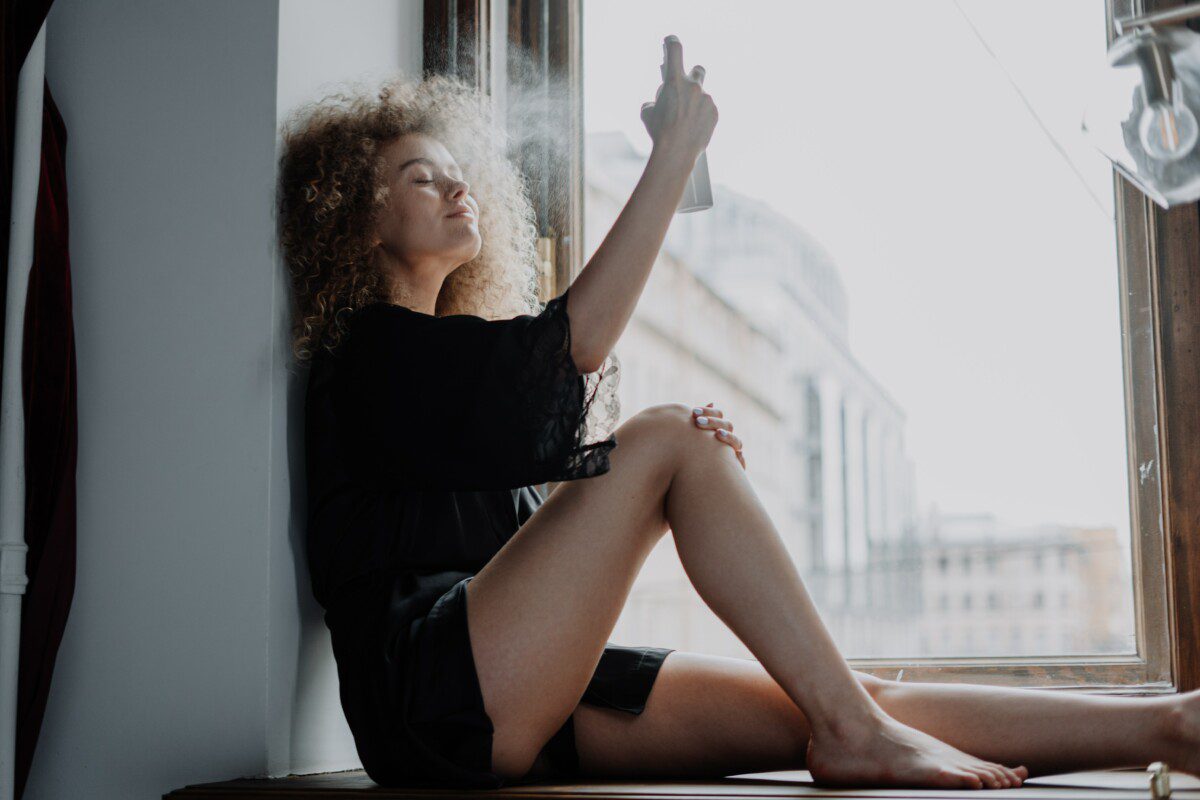




I just ordered an aera for my sons teacher. I hope she uses it!
Hi Desiree,
I hope so too! It’s not incredibly uncommon for schools and workplaces to implement “fragrance-free” policies… Since there are more people spending their days in these spaces, there is going to be a higher likelihood that at least a couple of those people are going to have chemical sensitivity, asthma, or something similar!
Which “experts” made these assertions with regard to health related issues? What are their credentials and please cite studies confirming findings.
Hi Lynn, Studies and sources such as the EPA, etc. are hyperlinked throughout. 🙂
My forth grade sons teacher these. He’s ony been in her class for a day and when my husband called to express concerns the principal said she had 2 and will unplug one. And if we want take both out. of course he didn’t say yes but he will be tomorrow. I dont want my son getting asthma. He already has bad allergies as it is. His backpack smells so strong of it when he came home. I hate to imagine what’s lingering in his lungs. she’s such a sweetheart. I hope she’s open to the first product you recommended. Even in these hard times I am willing to invest for her sacrifice.
Hello there, I’m curious as to if the wallflower refills that are citrus, are OK for cats.
We wouldn’t recommend them since it’s not clear what types of ingredients are actually in their “fragrances.”
Just wanting to correct the pet that says Bath and Body doesn’t list their ingredients on their body care products. Wether they are safe or not is a whole different subject. But I never just take what’s written without checking it. I have a lotion right in front of me and if it allowed I’d post a picture of the plainly listed ingredients plus the fragrance and #s listed by it. And it is cruelty free. States in on each product so that is partial info given in the article. I have friends who have taken the time Essential oil top head products and they have been harmful. Everything must be used with caution. Just because it’s all natural and the ingredients seem perfectly fine, you may be allergic to them. That aside I just feel like if you are going to include all the Bath and Body products in one swoop under the category of “fragrance” catch all we need to be more accurate than that.
Hi Lurlene,
Thank you for your input! We agree that individuals should always check for themselves whenever they receive a piece of information. This article is more about the Wallflower plug-ins, not the lotions, etc. (The labeling requirements can vary based on the type of product.) But I am intrigued that you have a bottle of lotion with even the fragrance ingredients listed on it. If you’d like to email a photo to us at [email protected], please feel free to do so. We’re also curious where you are located/what country you bought the bottle of lotion from. Labeling laws differ by country as well.
Lastly, it is definitely true that some essential oils are much safer than others, that they should always be used properly and in correct dosages, and that some people are allergic to them. Ultimately, we believe consumers should be informed on what’s actually in the products they buy. What we don’t like is when brands make claims such as “this product is made with essential oils” as a marketing ploy to make consumers think it’s “all-natural” when it actually contains other synthetic chemicals and more.
Thank you for this information. I decided to check the chemical composition of Bath and Body Wall flower product when my sister noticed that the vapors from a wall flower plugin located under a range hood caused deterioration of the white paint on the underside of the hood. The paint was dissolved down to the bare metal with discoloration of the surrounding area directly above the wallflower. This reaction also resulted in a brownish liquid running down the back wall.
That doesn’t sound too good! Thanks for sharing, Logan!